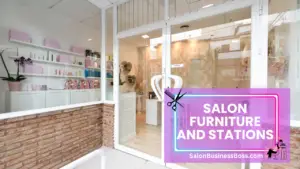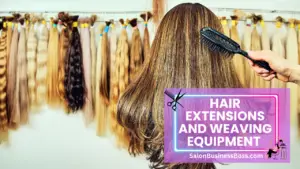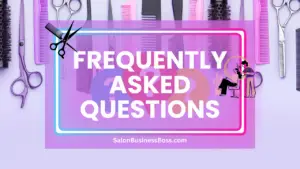Hair salons have become synonymous with style, self-expression, and beauty. Behind every successful hair salon is a carefully curated collection of state-of-the-art equipment that enables hairstylists to work their magic and create stunning transformations.
Hair salon equipment includes essential components like ergonomic salon chairs, high-quality cutting tools, hair color mixing bowls, versatile styling tools, and efficient reception POS systems. From creating stunning haircuts to offering rejuvenating treatments, these equipment pieces form the backbone of a modern hair salon, ensuring a seamless and enjoyable experience for both stylists and clients. Embrace innovation and invest in top-notch equipment to thrive in the competitive world of hair salons.
1. Salon Furniture and Stations

A well-designed and equipped hair salon plays a crucial role in creating a positive and enjoyable experience for both hairstylists and their clients. The foundation of any hair salon begins with functional and stylish furniture and stations, which serve as the backbone of the salon’s ambiance and efficiency. Among the key elements of salon furniture, the salon chair takes center stage, providing comfort and support to clients during their hair services.
An essential quality of a quality salon chair is its ergonomic design. These chairs are specifically engineered to promote proper posture and reduce strain on the body during extended styling sessions. The ergonomic features of salon chairs help prevent discomfort and fatigue for both clients and hairstylists, allowing them to focus on the art of hairstyling without distractions.
Adjustable heights are another indispensable aspect of a quality salon chair. The ability to adjust the chair’s height ensures that clients of varying heights can be comfortably positioned for their hair services. Whether the client is tall or short, the hairstylist can easily adapt the chair’s height to achieve an optimal working position, enhancing the stylist’s precision and efficiency.
Swivel capabilities add another layer of convenience to the salon chair. The ability to rotate the chair allows hairstylists to access different angles of the client’s hair without the need to reposition themselves constantly. This enhances the hairstylist’s workflow, promoting a seamless and uninterrupted styling process.
Well-designed styling stations are essential components of a functional hair salon. Styling stations typically include built-in mirrors and ample storage space for styling tools, products, and accessories. The mirror not only allows clients to view the hairstyling process but also serves as a tool for hairstylists to ensure precision in their work.
The presence of ample storage space in styling stations is crucial for maintaining organization and convenience within the salon. Hairstylists can keep their essential tools and products close at hand, reducing the need for unnecessary movement and saving time during hair services. This efficient setup allows for seamless communication between hairstylists and their clients, fostering a comfortable and engaging environment.
A carefully crafted foundation of functional and stylish furniture and stations contributes significantly to the overall success of a hair salon. By investing in high-quality salon chairs with ergonomic features and versatile styling stations, salon owners can create a welcoming and efficient workspace that promotes excellence in hairstyling and leaves clients delighted with their salon experience.
Read more about: Hair Salon Equipment List: Empowering Your Stylists
2. Hair Cutting and Styling Tools
Hair cutting and styling tools form the foundation of every successful hair salon, as they are the implements that hairstylists rely on to craft stunning and transformative looks for their clients. At the core of a stylist’s toolkit are high-quality shears and scissors, which serve as their primary instruments for achieving precise and seamless haircuts.
The importance of having different types of shears cannot be overstated. Straight-edge shears are the go-to for standard haircuts, providing clean and even cuts. Thinning shears, on the other hand, are designed to remove bulk and add texture to the hair, creating a softer and more natural look. Texturizing shears are another valuable addition to the stylist’s repertoire, allowing for subtle blending and layering to achieve sophisticated and modern hairstyles. Each type of shear serves a specific purpose, giving hairstylists the versatility they need to cater to a wide range of client preferences and hair types.
Beyond shears, a comprehensive set of styling tools is essential to a well-equipped salon. Flat irons are indispensable for achieving sleek, straight styles or elegant waves, while curling wands offer the flexibility to create bouncy curls or loose beach waves. Blow dryers are a staple in every salon, used for both drying and styling hair. They provide control and volume, making it easier for hairstylists to achieve their desired looks.
Hot rollers are a timeless styling tool that creates long-lasting curls and volume. They are particularly useful for special occasion styling, providing clients with glamorous and red-carpet-worthy hairdos. From everyday looks to bridal hairstyles, hot rollers are a stylist’s secret weapon for achieving stunning and sophisticated results.
The versatility of these styling tools extends beyond their use in daily salon operations. They are also indispensable for creating special occasion looks for weddings, parties, and other events. With the right set of styling tools, hairstylists can transform their clients’ appearances and boost their confidence for any occasion.
3. Hair Color and Treatment Equipment
Coloring and hair treatment services have become integral aspects of modern hair salons, as clients seek to experiment with different hair colors and nourish their hair to maintain its health and luster. To deliver these services with precision and effectiveness, hair salons must equip themselves with the right tools and equipment.
Hair color mixing bowls and brushes are essential tools for hairstylists when applying hair color. These tools allow stylists to mix hair color products to the desired shade and consistency, ensuring accurate color application. The use of color brushes ensures even distribution of color, preventing patchy or uneven results. Additionally, foiling tools are indispensable for highlighting and balayage techniques, providing hairstylists with precise control over color placement and achieving seamless blending.
Hair treatments, such as deep conditioning and hair masks, require specific equipment to maximize their benefits. Steamer caps are commonly used in hair salons to apply gentle heat, which helps open up the hair cuticles and enhances product penetration. This allows the treatment’s nourishing ingredients to deeply penetrate the hair shaft, providing hydration and repair to damaged or dry hair.
Hair processors are another valuable tool in hair treatment services. These devices emit controlled heat, ensuring consistent and uniform distribution of heat throughout the hair. Hair processors are particularly useful for treatments that require a longer processing time, such as keratin treatments and color corrections. The controlled heat helps accelerate the treatment process, allowing the products to work effectively, resulting in healthier and more manageable hair.
With the right equipment, hairstylists can offer a wide range of hair color and treatment services, tailoring them to each client’s unique needs and preferences. From subtle highlights to bold fashion colors, and from revitalizing treatments to deep repair sessions, the right equipment enhances the quality and outcomes of these services.
4. Hair Washing and Drying Stations
Hair washing and drying stations are integral to creating a positive and enjoyable salon experience for clients. These stations lay the foundation for a relaxing and refreshing journey that begins with a comforting hair wash and culminates in the effective drying of freshly cleansed hair.
A key component of a hair washing station is the shampoo chair or recliner. Comfort is paramount during the hair washing process, and these chairs are designed to provide maximum comfort and support to clients. Well-padded seats and reclining features ensure that clients can fully relax while their hair is being washed. The ergonomic design of these chairs also helps to reduce any strain on the client’s neck and back during the process.
Paired with the shampoo chairs are adjustable sinks, which further enhance the client’s comfort. The ability to adjust the height of the sink ensures that clients of different heights can be comfortably positioned for the hair wash. This customization adds to the overall positive experience, as clients can feel at ease throughout the process.
High-quality shampoo units are also crucial components of hair washing stations. These units are equipped with temperature-controlled water, allowing for a soothing and refreshing hair wash. The precise control over the water temperature ensures that clients are not subjected to extreme cold or hot water, further enhancing their comfort and enjoyment.
Following the hair wash, efficient hair drying is essential to complete the salon experience. Hooded hair dryers and bonnet dryers are commonly used for this purpose. These devices gently blow warm air over the hair, ensuring even heat distribution and efficient drying. Not only do these dryers expedite the drying process, but they also enhance the efficacy of various hair treatments, such as deep conditioning and color treatments.
5. Hair Extensions and Weaving Equipment

As the demand for hair extensions and weaving services continues to rise, hair salons must equip themselves with specialized tools and equipment to meet their clients’ expectations and deliver flawless results. Hair extensions provide clients with the opportunity to add length, volume, and versatility to their hair, making them a popular choice for those looking to transform their appearance.
Microbead tools are fundamental to the installation of microbead hair extensions, also known as I-tip extensions. These tools are used to secure small sections of hair to individual microbeads, which are then clamped shut to keep the extensions in place. This technique offers a natural and discreet look, allowing clients to wear their hair up or down without the extensions being noticeable.
Hair extension adhesive is another essential tool used in the installation of tape-in or glue-in extensions. The adhesive provides a strong bond between the extension and the client’s natural hair, ensuring a secure and long-lasting hold. Skilled hairstylists use this method to seamlessly blend the extensions with the client’s natural hair, creating a natural-looking and harmonious result.
Weaving needles are indispensable in the installation of sew-in hair extensions, which involve creating cornrows along the client’s scalp and sewing the extensions into these braids. The weaving needles allow hairstylists to navigate through the braids with precision, attaching the extensions securely and evenly across the scalp. This method is particularly suitable for clients with thicker hair, as it can support the weight of heavier extensions.
Extension pliers are vital tools used with microbead and bead-tip extensions. These pliers help in clamping the microbeads or bead-tips securely to attach the extensions to the client’s hair. They provide hairstylists with the necessary grip and control to ensure a seamless and long-lasting installation.
Fusion heat connectors are used in fusion or bonded hair extensions. This method involves attaching individual hair strands to the client’s natural hair using a keratin bond, which is fused together with a fusion heat connector. This process creates a durable and discrete bond, providing clients with a natural look and feel.
Read more about: Different Types of Salons (And Why They Matter)
6. Reception and POS Systems
Efficient salon management is crucial for the smooth operation and success of any hair salon. Streamlined reception and point-of-sale (POS) systems are essential components that play a significant role in enhancing productivity, organization, and customer satisfaction.
Computerized appointment scheduling software is a game-changer in the salon industry. Gone are the days of manual appointment books and time-consuming phone calls. With computerized scheduling, salon owners can manage appointments effortlessly, ensuring a seamless booking process for clients. This software allows customers to book appointments online, view available time slots, and even receive appointment reminders through email or text messages. Stylists benefit from a well-organized schedule, minimizing scheduling conflicts and maximizing their productivity, as they can plan their day efficiently and allocate time for each client’s specific needs.
Integrated POS systems are equally valuable in salon management, providing a centralized platform for various business operations. These systems combine payment processing, inventory tracking, and sales analysis into one comprehensive solution. As clients complete their hair services, the integrated POS system streamlines the payment process, making it quick and convenient for both clients and salon staff. The system automatically updates the salon’s inventory as products are sold or restocked, ensuring accurate stock levels at all times. Salon owners can also access sales data and reports, enabling them to analyze trends, track performance, and make informed business decisions.
By automating administrative tasks, streamlined reception and POS systems free up valuable time and resources for salon owners and staff. Salon owners can focus on delivering top-notch services to clients, which fosters client loyalty and positive word-of-mouth referrals. The efficiency of the systems also leads to reduced wait times for clients, enhancing their overall salon experience.
These digital systems offer increased customer satisfaction through personalized service. Salon staff can access client profiles with information about their preferences, past services, and product purchases. Armed with this data, stylists can tailor their services and product recommendations to suit each client’s individual needs and preferences, creating a more personalized and memorable experience.
Conclusion
Hair salon equipment plays a pivotal role in creating a successful and thriving salon business. From state-of-the-art styling tools to efficient salon management systems, each piece of equipment contributes to a seamless and enjoyable salon experience for both hairstylists and clients. By investing in high-quality equipment and staying up-to-date with the latest industry trends, hair salons can maintain their competitive edge and foster a loyal clientele base. Embracing innovation and prioritizing customer satisfaction are key factors that will lead to continued success in the ever-evolving world of hair salons.
Frequently Asked Questions

1. How can I ensure a seamless and enjoyable client experience in my salon?
Answer: Investing in high-quality equipment and staying updated with industry trends will contribute to a positive and enjoyable salon experience for clients.
2. What are the key factors to consider when upgrading salon equipment?
Answer: Consider the needs of your stylists and clients, as well as the latest technology and innovations to enhance the salon’s efficiency and services.
3. Can hair salon equipment be customized to match the salon’s aesthetic?
Answer: Yes, many equipment suppliers offer customizable options for furniture, styling stations, and chairs to match the salon’s overall theme and design.
To learn more on how to start you own salon checkout my startup documents here.
Please note that the contents of this blog are for informational and entertainment purposes only and should not be construed as legal advice. Any action taken based on the information provided in this blog is solely at your own risk. Additionally, all images used in this blog are generated under the CC0 license of Creative Commons, which means they are free to use for any purpose without attribution.

About the author. Entrepreneur and Salon Business Fan.
Hi! I am Shawn and I am a happy individual who happens to be an entrepreneur. I have owned several types of businesses in my life from a coffee shop to an import and export business to an online review business plus a few more and now I create online salon business resources for those interested in starting new ventures. It’s demanding work but I love it. I do it for those passionate about their business and their goals. That’s why when I meet a salon business owner, I see myself. I know how hard the struggle is to retain clients, find good employees and keep the business growing all while trying to stay competitive.
That’s why I created Salon Business Boss: I want to help salon business owners like you build a thriving business that brings you endless joy and supports your ideal lifestyle.


